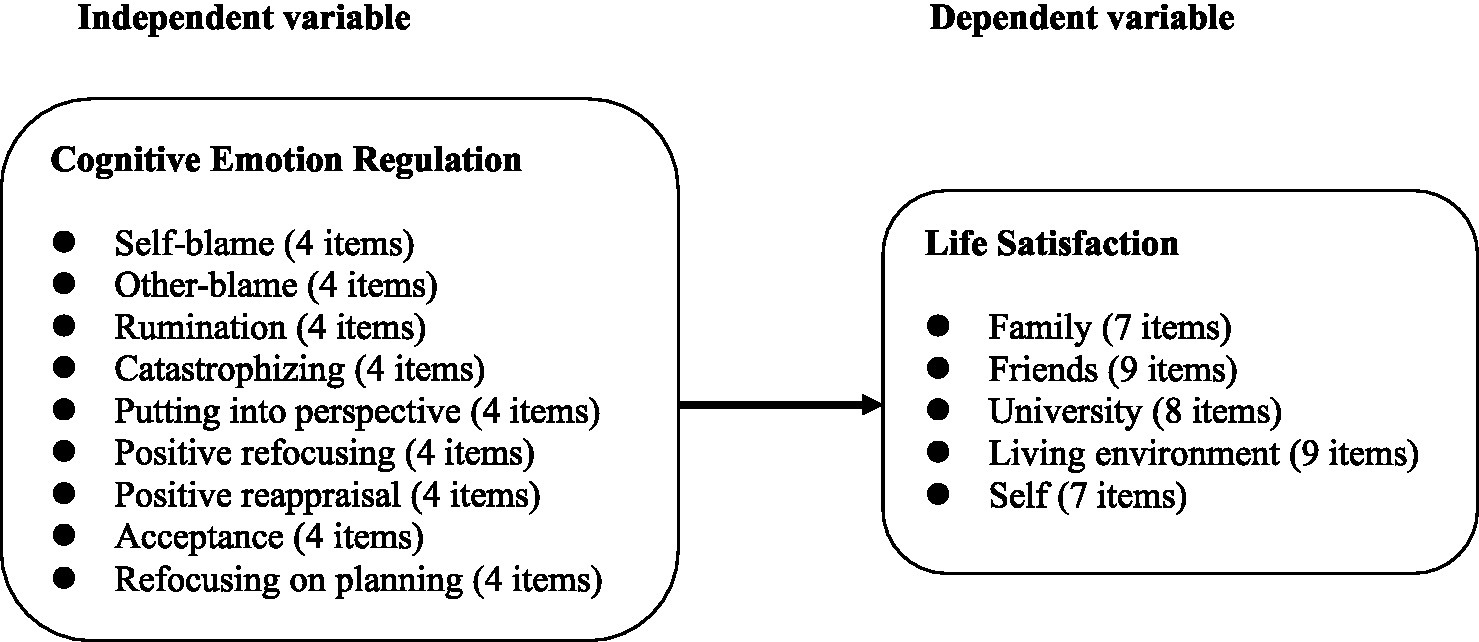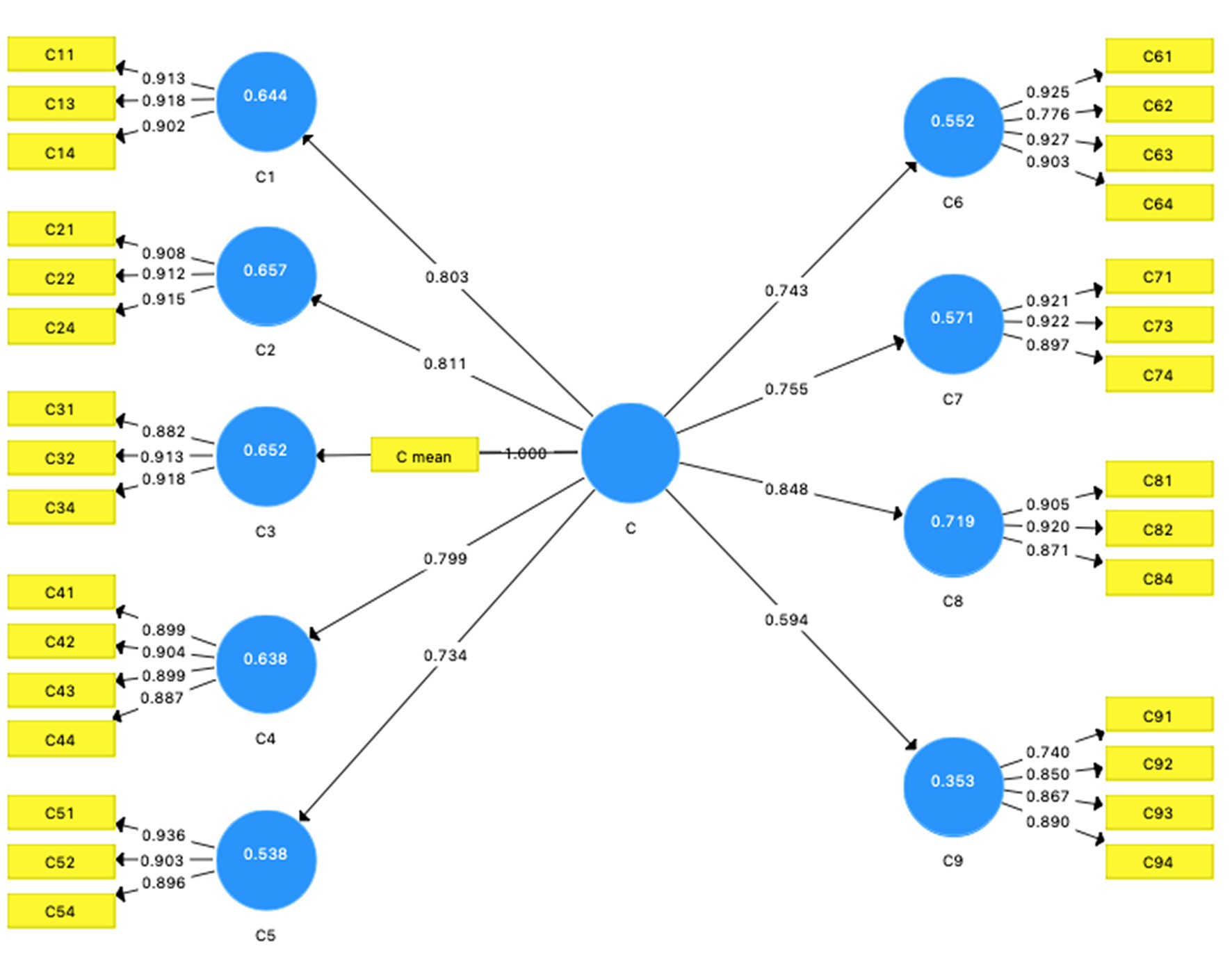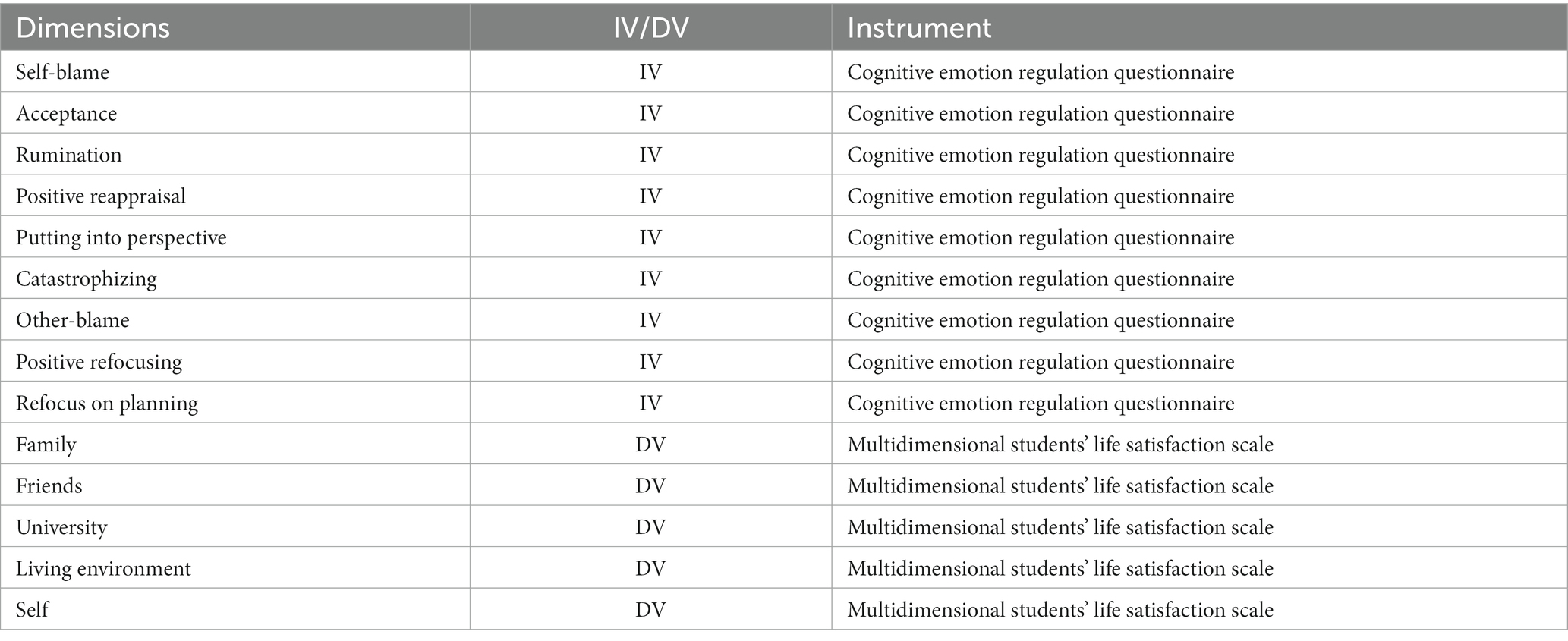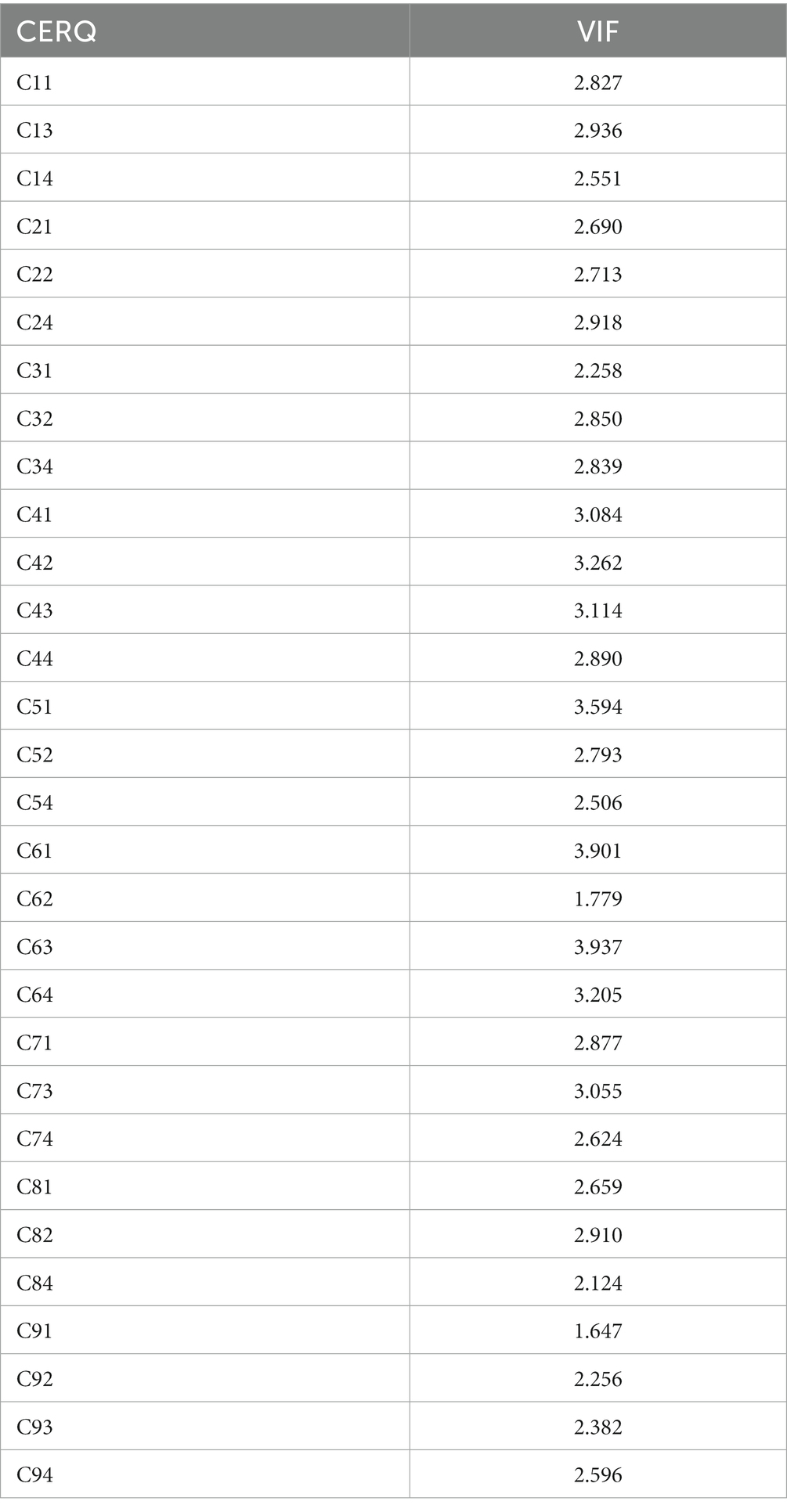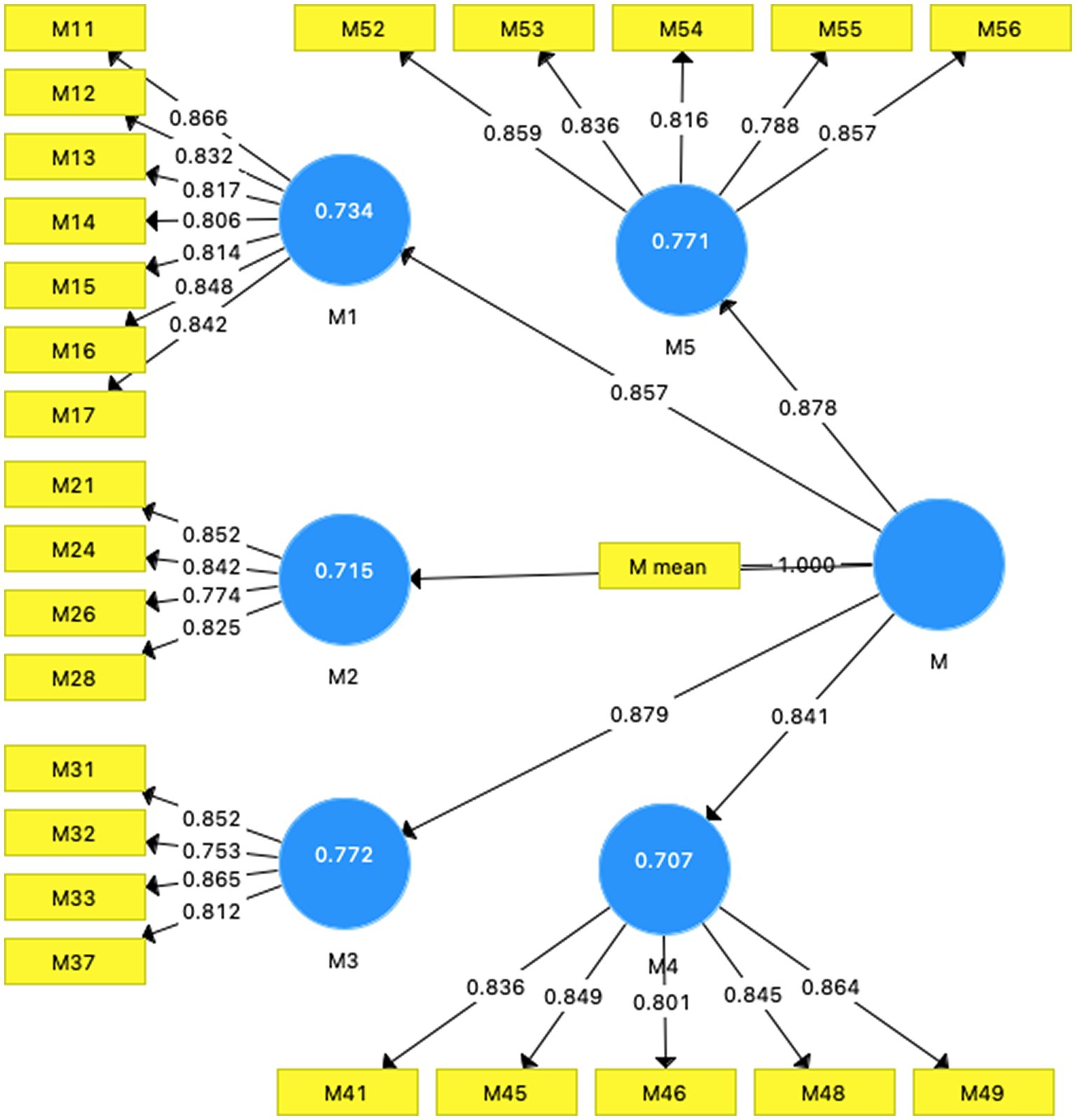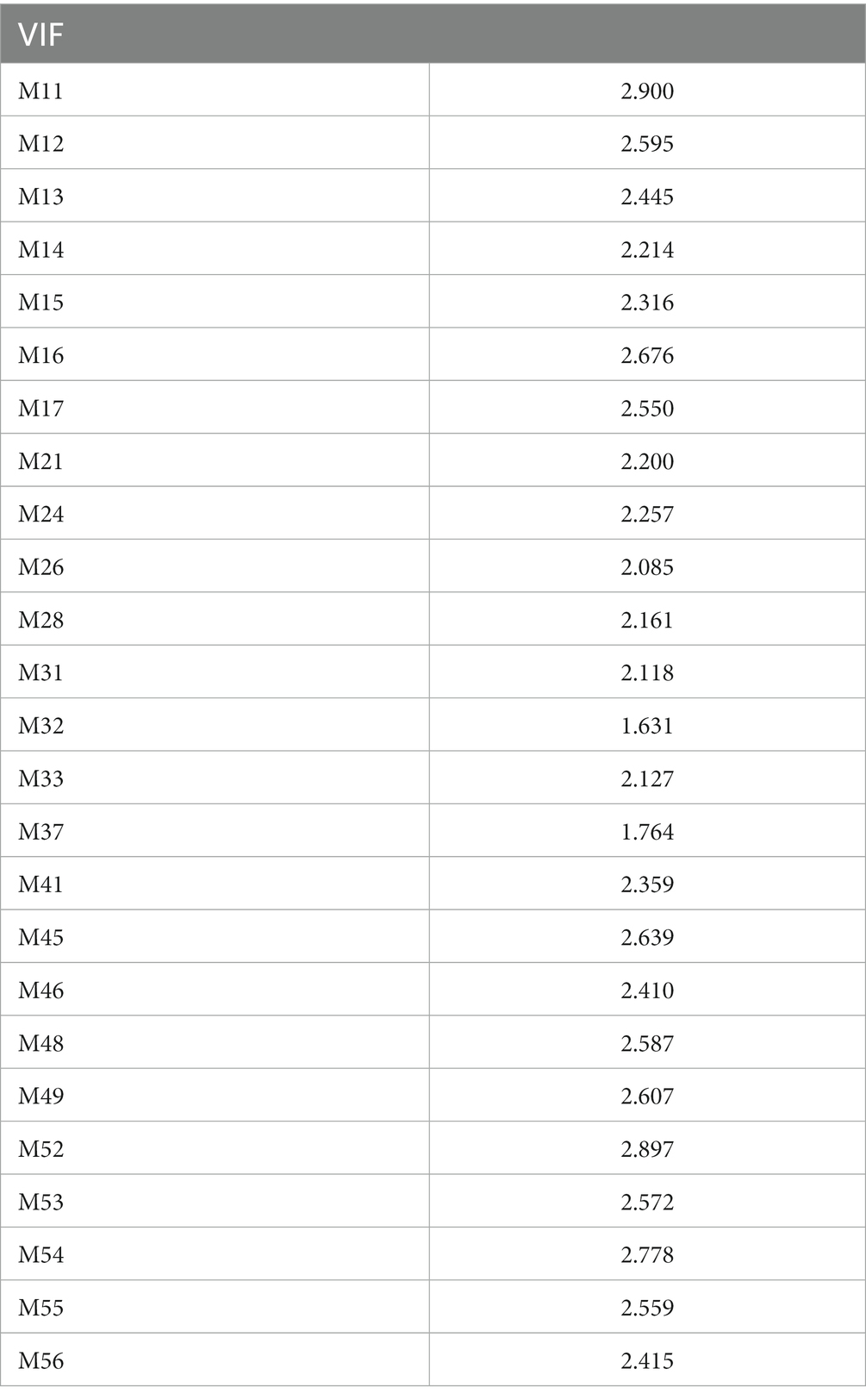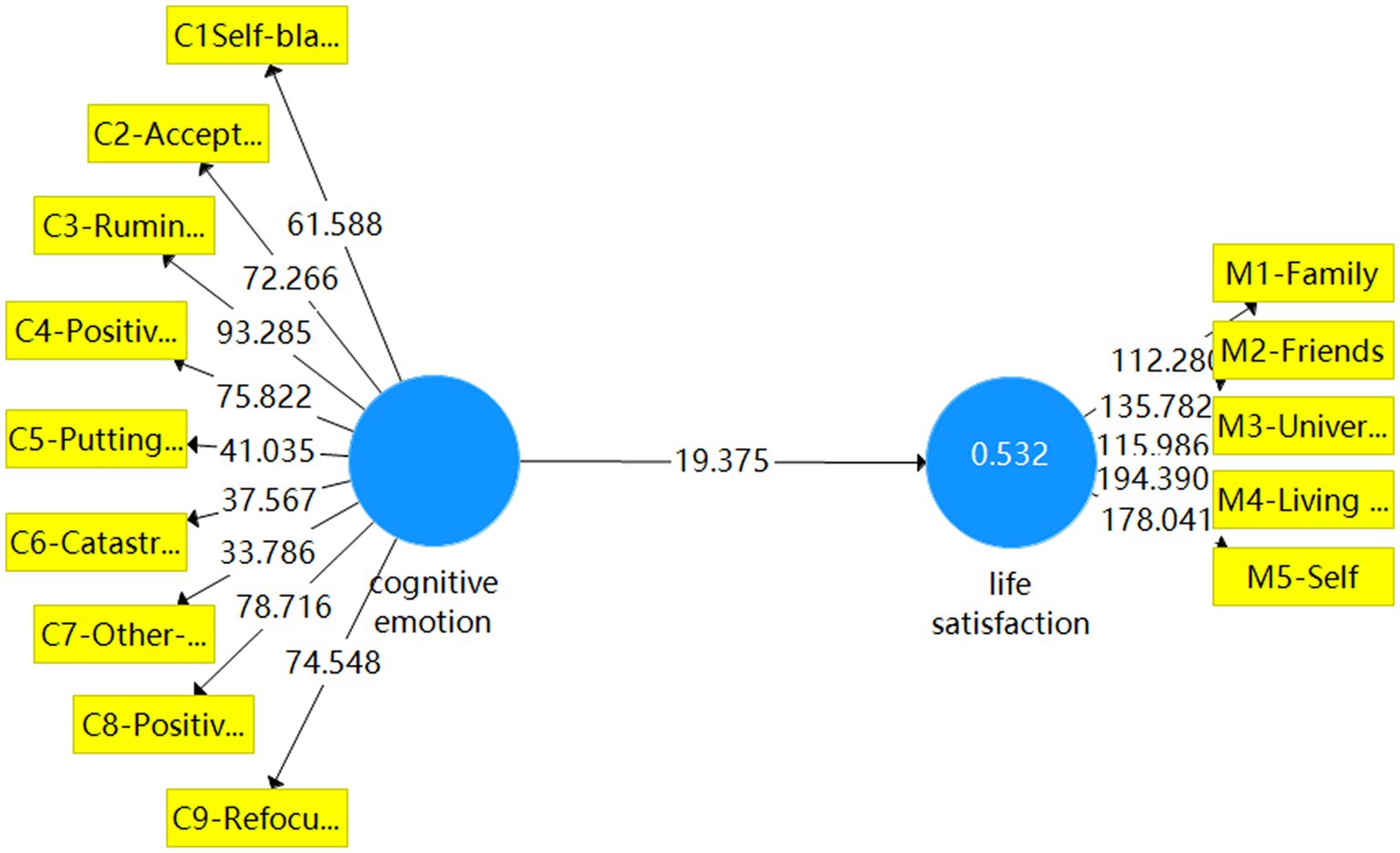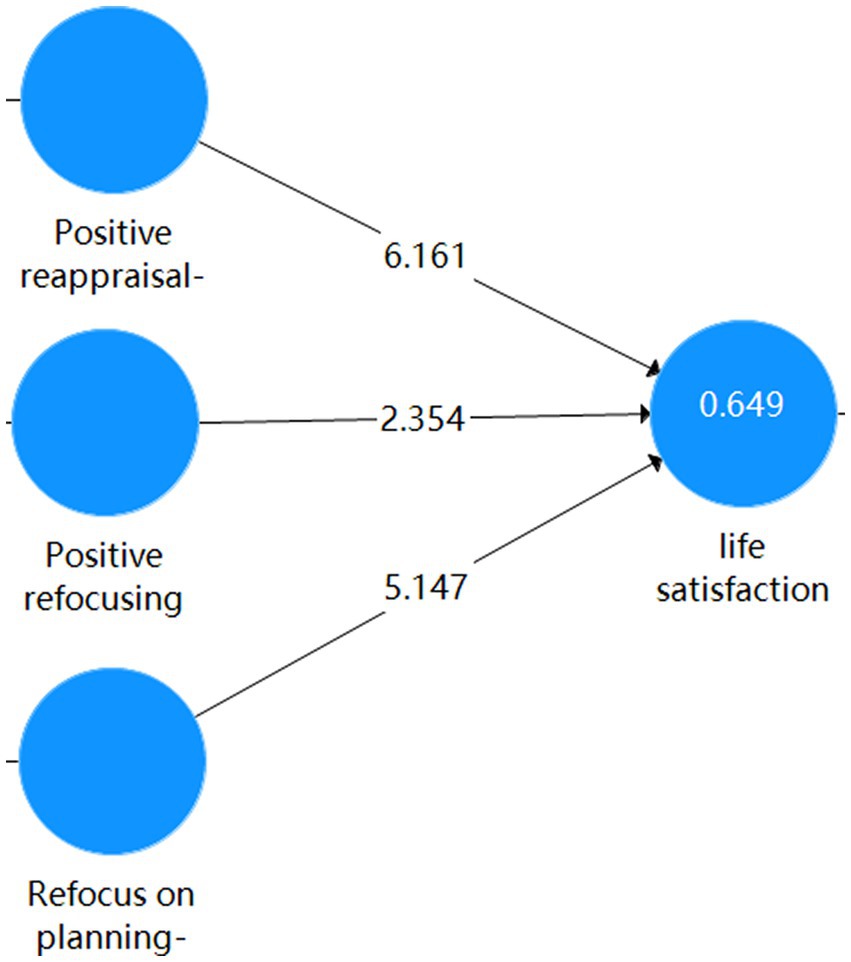- SEGi University, Kota Damansara, Malaysia
This study investigates the relationship between cognitive emotion regulation and life satisfaction among students from Mainland China in Malaysian universities. It aims to determine the level of life satisfaction, the frequency of using cognitive emotion regulation, the correlation between the two variables, and the predictive factors of life satisfaction. Four hundred and ninety (490) participants were selected from 12 universities in Malaysia through random sampling; 102 for a pilot study and 388 for the final study. A quantitative research design was developed to conduct the investigation using two questionnaires; the Multidimensional Students’ Life Satisfaction Scale (MSLSS) and a Cognitive Emotion Regulation Questionnaire (CERQ). Data were analyzed using the statistical tools SPSS 26 and Smart PLS (SEM) 3.0. The findings showed that a high proportion of participants (72.4%) demonstrated a high level of life satisfaction among students from Mainland China in Malaysian universities and 48.7% of these students always used cognitive emotion regulation. 12.6% of students from Mainland China displayed a low level of life satisfaction and 13.4% rarely used cognitive emotion regulation. In conclusion, there was a significant relationship between cognitive emotion regulation and life satisfaction, in which positive reappraisal, positive refocusing, and refocusing on planning of cognitive emotion regulation had significant predictive powers for life satisfaction among students from Mainland China in Malaysian universities.
1. Introduction
For most high school graduates, university life is a key moment in their lives before they begin their careers (Christie et al., 2005). This study focuses on the university students who fail to feel life satisfaction and meaningfulness upon their graduation. These students are likely to suffer feelings of dissatisfaction, overwhelmedness, and homesickness during their university studies for a variety of reasons, including the intervening changes (Lydster and Murray, 2019). Hence, addressing these issues and improving university students’ life satisfaction levels is of great significance to help them enjoy a better university life and accomplish greater academic achievement. Meanwhile, the existing literature has shown emotional sentiments to be indicators of both students’ academic performance and drop out rates at universities (Respondek et al., 2017).
1.1. Problem statement
Lewis et al. (2011) showed that Chinese university students have an unusually high prevalence of psychological discomfort, indicating that they are a high at-risk population group. This is due to the ignorance of the psychology education system, which has caused them to have low levels of life satisfaction. This indicates that life satisfaction is very crucial for international university students studying in another country. This means that a common phenomenon of a low level of life satisfaction exists among Chinese students; this is the first gap in this study.
Smith and Khawaja (2011) found that emotional repression may be used more frequently by Asian students as a way of emotion regulation, and depression is frequently regarded as one of the feelings in a person. For instance, when a student from Mainland China studies in a foreign country, they have no choice but to deal with the various mental discomforts, which can raise their risk of being depressed (Suri et al., 2013). This indicates that many of them do not use cognitive emotion regulation, causing emotion repression and depression issues in them. In short, the second research gap is that students from Mainland China rely more heavily on emotional suppression as a method of cognitive emotion regulation.
Suri et al. (2013) argued that there is a need to focus on the relationship between cognitive emotion regulation and life satisfaction, especially for students from Mainland China in Malaysia, due to insufficient research and literature. Even though Berking and Lukas (2015) provided evidence showing that cognitive coping methods are a potential strategy for treating psychopathology symptoms, no research has been conducted to see if the association between certain cognitive emotion regulation strategies and psychopathology is coherent across nations. For instance, it is noted that many university students experience obstacles as they adjust to social and academic demands. This causes depression, especially in Asian students. Moreover, Steger et al. (2006) found that emotion regulation has an impact on life satisfaction. This means that emotion regulation is crucial to life satisfaction. This study is conducted to support the relationship between cognitive emotion regulation and life satisfaction.
1.2. Conceptual framework
A conceptual framework is a versatile analytical tool that may be used in a variety of situations. It may be used in a variety of fields where an overall image is required. It is used to arrange concepts and create conceptual distinctions. Strong conceptual frameworks capture something in an easy-to-remember and apply manner (Ager and Strang, 2008). This study aimed to investigate the relationship of two variables, namely, cognitive emotion regulation and life satisfaction, where the former influences the latter among Mainland China students in Malaysian universities. Figure 1 shows the conceptual framework that guided this study.
This conceptual framework is based on cognitive emotion regulation influencing life satisfaction. Cognitive emotion regulation is an independent variable with nine dimensions, as depicted in the conceptual map below: self-blame, other-blame, rumination, catastrophizing, putting into perspective, positive refocusing, positive reappraisal, acceptance, and refocus on planning. The dependent variable is defined as life satisfaction, consisting of five dimensions: family, friends, university, living environment, and self. The conceptual framework, as explained in Figure 2, provides nine dimensions of cognitive emotion regulation influencing life satisfaction.
Bastian et al. found that positive emotion regulation is strongly related to life satisfaction. This theory highlights the significance of the relationship between cognitive emotion regulation and life satisfaction, and the predictive power of cognitive emotion regulation strategies contributing to life satisfaction, such as positive reappraisal, refocus on planning, and acceptance (Garnefski et al., 2002; Omran, 2011; Suri et al., 2013). So this conceptual framework is applied in this study to Mainland China students who are studying in Malaysian universities.
1.3. Significance of the study
The findings of this research are of great significance both theoretically and practically in terms of cognitive emotion regulation and life satisfaction.
Specially, the findings of the present study add to the existing body of knowledge on cognitive emotion regulation and life satisfaction theories by analyzing the correlation between cognitive emotion regulation and life satisfaction. According to the gaps and research objectives of this study, the findings provide specific information about the level of life satisfaction and usage frequency of cognitive emotion regulation among Mainland China students in Malaysian universities.
Furthermore, this study revealed the cognitive emotion regulation strategies that are crucial for international university students to achieve life satisfaction. Therefore, the data gathered can provide excellent suggestions to Mainland China students Malaysian universities on how to apply cognitive emotion regulation in improving life satisfaction levels. Finally, based on the results of this study, we hope to assist university teachers in guiding international students on how to use cognitive emotion regulation strategies to achieve life satisfaction and to guarantee that students successfully achieve their academic objectives.
2. Research methods
2.1. Population and sample
According to Datuk Seri Dr. Noraini Ahmad (Minister of Higher Education Malaysia; MOHE, 2021), there are approximately 20,000 registered Chinese students studying in Malaysia’s public and private higher education institutions as of June 2021. In this study, public as well as private Malaysian universities were selected for data collection to avoid bias caused by the nature of the university.
This research sample consisted of 388 multiple grade university Chinese students (218 males and 172 females) in Malaysia who were selected using a simple random sampling method. The simple random sampling, in which each and every member of the population has an equal chance of being selected, is the best way to present the population (Etikan et al., 2016). Because the researchers could approach the various groups of Chinese students in public and private universities, a total of 12 universities joined the present study; eight universities were public and four private, out of the 12 universities in Malaysia, irrespective of their age and field of study.
All participants are Mainland China students who are studying in different faculties in public and private Malaysian universities. The survey was voluntary and participants were informed of their willingness to take part or withdraw from this study. Signing the consent form implied their willingness to be part of the study. To guarantee that the participants in this study were minimally influenced and to ensure the stability of students’ emotion, the questionnaires were sent to students who were attending classes as normal.
2.2. Instruments
Two sets of questionnaires were used as research instruments in this study: a cognitive emotion regulation questionnaire (CERQ) and the multidimensional students’ life satisfaction scale (MSLSS). The questionnaire was designed by Gross (2016) and the scale by Schnettler et al. (2015).
Cognitive emotion regulation was used to identify specific cognitive emotion control methods that participants utilized in response to exciting or stressful life experiences (Ochsner and Gross, 2008). It is also used for different populations such as adolescents, adults, elderly people, and students (Garnefski et al., 2002). The CERQ is a 36-item self-report questionnaire that is simple to administer (Garnefski et al., 2002). The questionnaire examines 9 distinct cognitive coping mechanisms and was developed using both theoretical and empirical data. Individual cognitive coping mechanisms may be identified using the CERQ, which can then be compared to norm scores from other populations.
The original MSLSS was designed for children and adolescents, as a literature review reflected that a number of previous research studies utilized the MSLSS in university students (Huebner et al., 1998; Gilman et al., 2000; Huebner and Gilman, 2012; Schnettler et al., 2015; Tian et al., 2015). Parts referring to school were replaced with university-based questions and then the reliability and validity were tested. To validate the surveys and to eliminate any misunderstandings among the participants, a reverse translation approach was used. To preserve accuracy, the original surveys were translated to Chinese and then translated back to English. Table 1 provides a summary of the variables, specifying which variable was used for each research question, whether the variable is independent or dependent, and from which instrument the data were obtained. These two instruments are elaborated upon in detail in the following section.
2.3. Reliability and validity
A pilot study was conducted to see if the research methods performed effectively with the research objectives and research questions used in this study. The obtained data from the questionnaires were assessed to ensure that the instruments’ reliability and validity were met. A total of 102 participants joined the pilot study using two questionnaires which were sent to the participants via WeChat.
To test the reliability and validity of the formal study, a measurement model was established via the statistical tool Smart PLS. The first procedure of the measurement model testing was to check the values of the factor loadings. The second procedure was to determine the reliability, and validity of the instruments, Cronbach’s alpha value, composite reliability, and average variance extracted value. Lastly, the the variance inflation factor (VIF) values of the two instruments were tested and presented.
As demonstrated in Table 2 and Figure 2, the Cronbach’s alpha values ranged from 0.859 to 0.919, suggesting a high level of reliability. Additionally, the composite reliability value minimum should be more than 0.70 and the maximum less than 0.95 (Hair et al., 2019). The result in this study reached a high level of more than 0.9 and less than 0.95, indicating the consistency of the research instruments. AVE values should be higher than 0.5 to ensure convergent validity; the results showed that all figures were higher than 0.8, suggesting that convergent validity was confirmed.
The VIF is often used to evaluate the collinearity of the formative indicators. VIF values of 5 or above indicate critical collinearity issues among the indicators of formatively measured constructs. However, collinearity issues can also occur at VIF values lower than 5; ideally, the VIF values should be close to 3 or slightly lower (Hair et al., 2019). Table 3 shows that all the items’ VIF values are less than 5, with most items close to 3 or slightly below, indicating that collinearity is not an issue in this study.
As presented in Table 4 and Figure 3, the Cronbach’s alpha values ranged from 0.839 to 0.926, suggesting a high level of reliability. Additionally, the composite reliability reached a high level of more than 0.8, indicating the consistency of the research instruments. AVE results showed that one figure was over 0.7 and that other figures were higher than 0.8, suggesting that convergent validity was confirmed.
Table 5 showed that all items VIF values are less than 5, and that all items are lower than 3. In summary, the results showed that the two instruments used in this study reached a high level of reliability and validity, indicating the consistency of the research instruments. Moreover, their convergent validity was strongly confirmed. The variance inflation factor values were close to and lower than 3, indicating that collinearity is not an issue in this study. Therefore, we can proceed with further data analysis to answer our four research questions.
3. Findings and discussion
A 7-point Likert Scale was used in this study, consisting of scores of 1 (strongly disagree), 2 (disagree), 3 (slightly disagree), 4 (neither agree nor disagree), 5 (slightly agree), 6 (agree), and 7 (strongly agree; Joshi et al., 2015). The 7-point Likert Scale performs better and provides more varieties of options which in turn increase the probability of meeting a person’s objective reality. The interpretation of these responses was calculated by using the formula: Interval = (the highest score–the lowest score)/the number of the interval (Widodo and Chandrawaty, 2021); for this study, interval = (7–1)/7 = 0.86. Subsequently, the level of mean scores was divided into three categories: low, moderate, and high (Widodo and Chandrawaty, 2021). The low level ranges from 1 to 2.73, the moderate from 2.74 to 5.31, and the high from 5.32 to 7. Level 1 accounted for 12.6% of participants, level 2 for 15%, and level 3 for 72.4%; therefore, 12.6% students experience a low, 15% a moderate, and 72.4% a high level of life satisfaction. This means that most Chinese university students are very well satisfied in their lives; however, a small number still experience moderate and low levels of life satisfaction (Table 6).
The findings of the first research objective are consistent with those of Lin and Zheng (2007), who found that Chinese university students have a high level of life satisfaction. However, the findings are contradictory to Eisenberg et al. (2007) and Tsitsas et al. (2019), conducted in western samples, who discovered that the majority of university students have a low level of life satisfaction, with no gender differences observed.
Pavot and Diener (2008) also showed that when the original information related to life satisfaction changes, the reported level of life satisfaction changes as well. Furthermore, Paschali and Tsitsas (2010) showed that students who have a low level of anxiety have a high level of life satisfaction. Therefore, we assume that students from Mainland China in Malaysian universities have less anxiety and different cultural backgrounds compared to western countries.
This finding can be attributed to the following factors: one primary factor can be the lower anxiety of modern university students studying in Malaysia. Another potential factor may be that different cultures and environments lead to different levels of life satisfaction, such as in the majority of university students having a low level of life satisfaction with no gender differences observed in Western samples (Eisenberg et al., 2007; Tsitsas et al., 2019). Furthermore, life satisfaction has a positive link with self-esteem, familiar relationships, attributional styles, hopefulness, interpersonal relationships, and self-efficacy (Rezaei and Khosroshahi, 2018). Tsitsas et al. (2019) also showed that when students have strong assertiveness ratings, they are more likely to have high life satisfaction scores; therefore, students from Mainland China in Malaysian universities have a high level of life satisfaction because they have more confidence.
Moreover, when compared to urban university students, rural university students experience a greater degree of worry and stress (Bayram and Bilgel, 2008); therefore, urban university students are more satisfied with their life. Previous studies showed that life satisfaction in western countries is not optimistic and that in the United States, mental health problems are estimated to account for over half of the entire burden of disease among young adults (Eisenberg et al., 2007). In a 2005 national survey of university counselling center directors, 86% reported an increase in severe psychological problems among students (Eisenberg et al., 2007). Thus, different cultures and environments lead to different levels of life satisfaction.
To explore other factors that affect life satisfaction in university students, some aspects, such as anxiety, stress, and emotion regulation, which have a detrimental influence on life satisfaction, are discussed. Many studies have reported that high anxiety is linked to decreased levels of life satisfaction (Headey et al., 1993; Cook et al., 2000; Tsitsas et al., 2019). Researchers (Extremera et al., 2009; Schiffrin and Nelson, 2010; Tsitsas et al., 2019) have also related stress with life satisfaction among university and college students. Academic competence, academic culture shock, academic resources, intercultural communication, and pressure were also identified as important stresses for Mainland Chinese university students (Meng et al., 2018). Finally, emotion regulation can also predict academic achievement and dropout intentions in students (Respondek et al., 2017). As discussed above, some factors such as anxiety, stress, living environment, and emotion regulation all influence university students’ life satisfaction; therefore, less anxiety and stress and better utilization of emotion regulation strategies predict higher life satisfaction levels.
The mean values were divided into three levels (Widodo and Chandrawaty, 2021); level 1 ranged from 1 to 2.73, indicating that the respondents rarely used cognitive emotion regulation, level 2 (2.74–5.31) indicates that the respondents sometimes use cognitive emotion regulation, and level 3 (5.32 to 7) indicates the most frequent usage of the strategy. Table 7 shows that level 1 corresponded to 13.4% of participants, 2 to 37.9%, and 3 to 48.7%, which means that 13.4% of students rarely use cognitive emotion regulation, 37.9% use it sometimes, and 48.7% use it often. The data showed that out of a total of 380 participants, 51 Chinese university students rarely use cognitive emotion regulation strategies, 144 sometimes use them, and 185 students always use them. Therefore, almost half of Chinese university students in Malaysia always use cognitive emotion regulation strategies.
This finding is supported by Cheng and Suri et al. (2013), who also found that students from Mainland China adopted emotion regulation strategies when studying in universities. The Cheng study showed that participants from Mainland China used a wide range of emotion regulation strategies; furthermore, Suri et al. (2013) suggested that international university students use adaptive cognitive emotion regulation strategies to adequately achieve life satisfaction. These findings are consistent with the findings of the present study. Webster and Hadwin (2015) also explained that cognitive emotion regulation is significant to university students, indicating that successful students proactively and strategically regulate their cognition, motivational states, and behaviors. This finding was contradictory to Smith and Khawaja (2011), conducted in Asian students, who found that they rarely use cognitive emotion regulation.
According to Miyamoto and Xiaoming (2011), different cultural backgrounds lead to different usage frequencies of cognitive emotion regulation. It was found that positive emotion regulation is more prevalent in Westerners than in Asians. Secondly, as well as the negligence of cognitive emotion regulation education in Chinese and family education, one study believed that the control of emotions has been a neglected issue in educational study (Pekrun and Linnenbrink-Garcia, 2012). The Chinese education system and family education place a high value on basic subject performance, causing all educational participants, whether teachers, students, or their parents, to regard subject performance as the most important aspect of their studies. As a result, emotion regulation strategies and courses on fundamental understanding for Chinese students should be explored for inclusion in the education system.
Table 8 and Figure 4, show the results of path coefficients between CER and LS, which indicated that the relationship between them is significant. In this case, the T statistic is 19.375, which is greater than 1.96, and the p value is 0.000, which is smaller than 0.05. Therefore, according to these values, the effect on cognitive emotion regulation and life satisfaction is significant. Based on the path coefficient of the structural model, R squared is 0.532, which means that 53.2% of cognitive emotion regulation contributes to life satisfaction.
This finding indicates a positive correlation between cognitive emotion regulation and life satisfaction, which is consistent with Schutte et al. (2009), whose findings confirmed a strong connection between the two variables. Schutte et al., also discovered a substantial relationship between life satisfaction and various emotion regulation strategies. Suri et al. (2013) and Haga et al. (2009) have also found that there is a relationship between different emotion regulation strategies and life satisfaction. Szczygieł and Mikolajczak (2017) claimed that perception, expression, understanding, and management of emotions all play a part in fostering life satisfaction. The findings are similar to other research that discovered that men and women manage their emotions in various ways to achieve life satisfaction (Suri et al., 2013; Yiğit et al., 2014). Other research also supported that there is a considerable link between life satisfaction and various emotion regulation strategies (Haga et al., 2009; Schutte et al., 2009). It was also discovered that life satisfaction, positive emotion, negative emotion, and depression had significant relationships (Durak et al., 2010), despite the fact that managing emotions is a prerequisite to achieve life satisfaction (Yiğit et al., 2014). A similar result reported in another study indicated that positive emotions, rather than negative emotions, appear to play a larger role in the relationship between emotion regulation and life satisfaction (Szczygieł and Mikolajczak, 2017).
The findings of the third research objective can be attributed to the following factors. Emotion regulation, in particular, promotes the incidence of happy feelings, while reducing the frequency with which unpleasant feelings occur, resulting in a stronger sense of life satisfaction, indicating that trait emotion regulation plays a unique role in explaining people’s perceptions of life quality (Szczygieł and Mikolajczak, 2017). Thus, using various cognitive emotion regulation strategies, students can strive to alleviate psychological suffering. These findings are beneficial for university students, particularly those who are dealing with depression and academic difficulties.
Another factor may be that emotion regulation is essential for university students to balance their academic stress and university life; for instance, Yiğit et al. (2014) found that among university students, emotion regulation is the most important predictor of life satisfaction. The last potential factor is that emotion regulation plays a significant role in university students’ social relationships. One study showed that trait emotion regulation is critical for a variety of facets regarding adaptability that are good for students, from the standpoint of emotional behavior and social relationships (Szczygieł and Mikolajczak, 2017). According to a study conducted in Canada, there is a significant positive link between the quality of new friendships and adjustment to university life; especially for those who are new university students and experience a series of problems that contribute to poor adjustment, including homesickness and missing friends (Buote et al., 2007). In a nutshell, emotion regulation plays a unique role in life satisfaction.
Table 9 and Figure 5 show that the p values of positive reappraisal, positive refocusing, and refocus on planning are < 0.05, which indicates that they are significant to life satisfaction. The positive reappraisal T statistic = 6.161, the positive refocusing T statistic = 2.354, and the refocus on planning T statistic = 5.147, further suggesting that positive reappraisal is one of the main cognitive emotion regulation variables influencing life satisfaction, followed by refocus on planning and positive refocusing. According to Figure 5, the R2 value is 64.9%, which means that positive reappraisal, positive refocusing, and refocus on planning contribute 64.9% to life satisfaction.
The results related to research objective four are consistent with previous research (Gross and John, 2003; Garnefski et al., 2004; Suri et al., 2013), which found that positive reappraisal, refocus on planning, and positive refocusing are significantly and positively correlated with life satisfaction. Omran (2011) also showed that positive reappraisal is associated with low levels of anxiety and sadness. A similar result of another study suggested that it is adversely connected with depression and anxiety symptoms (Suri et al., 2013). These findings are identical in students from Mainland China in Malaysian universities: positive reappraisal, positive refocusing, and refocus on planning are strong predictors of cognitive emotion regulation for life satisfaction.
Another study suggested that positive reappraisal is negatively related to depression and psychological illness (Garnefski et al., 2004). This is partly consistent with the finding of our study, in that positive reappraisal of cognitive emotion regulation shows a significant association with life satisfaction. Positive reappraisal is the strongest predictor of life satisfaction in this study; in this aspect, this finding is consistent with other previous research (Gross and John, 2003; Garnefski et al., 2004; Omran, 2011; Suri et al., 2013).
Based on this finding and previous studies, the first potential factor may be that positive reappraisal could increase positive emotions, since people pay more attention to the positive side of life. In terms of the correlations between the dimensions of cognitive emotion regulation and life satisfaction, such as positive reappraisal, it has been discovered that it can promote appropriate actions and happy emotions while reducing negative sentiments (Gross and John, 2003). We can summarize the second factor as follows: cognitive emotion regulation strategies are mental reactions to stressful experiences that change one’s emotional state (Suri et al., 2013). The findings also suggested that those who employed positive reappraisal, positive refocusing, and refocus on planning tended to display a higher level of life satisfaction.
As discussed above, regarding the life satisfaction of university students, many studies have shown that university students are under academic stress, age stress, and so forth. This means that university students should learn some cognitive emotion regulation strategies so that they can deal with stressful situations. Regarding other strategies of cognitive emotion regulation that affect people’s life, previous studies have shown that ruminating, self-blame, and catastrophizing are all cognitive emotion regulation strategies that are favorably connected to depression and/or other indicators of mental ill-health, whereas, positive reappraisal is negatively related (Anderson et al., 1994; Garnefski et al., 2004). Many researchers reported that positive reappraisal is significantly and positively correlated with life satisfaction; thus, utilizing positive reappraisal is good for people’s mental health and since the findings of the present study are similar to previous research, we encourage university students to apply more cognitive emotion regulation strategies in university life, especially stressed situations.
Other factors were also discussed, for example, people may control their emotional experiences to some extent by adopting various emotion regulation strategies throughout their emotional episodes (Kashdan et al., 2015). The findings also showed that some cognitive emotion regulation strategies have a significant impact on both genders’ life satisfaction, whereas others have no impact (Suri et al., 2013). Moreover, positive emotions will lead to better life satisfaction (Boiger et al., 2013). Putting a social significance on happy emotions might help to draw attention to the unpleasant emotion experience as a source of worry, leading to more rumination and, as a result, lower life satisfaction (Nolen-Hoeksema et al., 2008; Mauss et al., 2011). Gross and John (2003) found that the experience of positive emotions is linked to reappraisal. In this way, putting a social value on pleasant emotions may help people feel better by strengthening the link between bad feeling and happiness. Cognitive reappraisal might be used to improve good sentiments and adaptive behavior by reducing negative feelings and increasing positive sensations (Suri et al., 2013). Therefore, focusing too much on positive emotion leads to backfire; it is important to learn to apply adaptive cognitive emotion regulation strategies and to balance positive and negative emotions.
4. Conclusion
The current investigation has significantly contributed to the correlation between cognitive emotion regulation strategies and life satisfaction, as well as the usage of cognitive emotion regulation among students from Mainland China in Malaysian universities. In general, “positive refocusing,” “refocus on planning,” and “positive reappraisal” of cognitive emotion regulations are related to life satisfaction. They are positive correlations that have also led to the discovery of additional data that were unexpected, necessitating further investigation to evaluate the findings. We suspect that some of these findings, which differ from those of other nations, are due to cultural differences. Finally, a favorable association was shown between cognitive emotion regulation and life satisfaction among Mainland China students in Malaysian universities. Furthermore, positive reappraisal, positive refocusing, and refocus on planning could be an intervention method applied by university teachers in class.
4.1. Limitations
The following is a summary of the limitations of the present study:
Firstly, owing to the limitations of time and space, we were unable to reach all the Mainland China students in Malaysia. Mainland China students were selected from 12 public and private Malaysian universities to be the sample population. Secondly, this study focused on the general background of Mainland China students in Malaysian universities; there are still many detailed backgrounds or differences that could be further explored, such as culture background or gender differences.
Finally, because the current study only analyzed Mainland China students in Malaysian universities, the results were limited to a single nationality and country. However, this research study could be used to explore more international students from other countries in Malaysian universities since there are still many international students from other countries who come to Malaysia to study in universities.
4.2. Implications
This study indicated that most Mainland China students in Malaysian universities have a high level of life satisfaction, which is consistent with a previous similar study (Lin and Zheng, 2007). It is contradictory to research conducted in western samples (Eisenberg et al., 2007; Tsitsas et al., 2019) and provides more information and discussion about different countries or different multi-cultural backgrounds that lead to different levels of life satisfaction in university students, which may be useful for future studies. Our findings also imply that there is still a small number of university students with a low level of life satisfaction. Therefore, it is recommended that university teachers and students should pay more attention to cognitive emotion regulation strategies to improve life satisfaction, in particular, Mainland China students who have a low level of life satisfaction.
Moreover, we found that cognitive emotion regulation influences life satisfaction among Mainland China students in Malaysian universities; other research also supported this finding that life satisfaction and emotion regulation do, in fact, have a significant relationship (Gross and John, 2003). This implies that cognitive emotion regulation is significant to life satisfaction. As the academic information about the topic of cognitive emotion regulation and life satisfaction among Mainland China students in Malaysian universities is limited, this study adds relevant academic information.
This study focused on cognitive emotion regulation strategies applied by university students to achieve life satisfaction, and we found that positive reappraisal, positive refocusing, and refocusing on planning are three strategies significant to life satisfaction without gender difference, consistent with many previous studies (Gross and John, 2003; Garnefski et al., 2004; Suri et al., 2013). The study implies that positive reappraisal, positive refocusing, and refocusing on planning are significant for life satisfaction among Mainland China students in Malaysian universities. These findings provide more specific cognitive emotion regulation strategies for university students’ to achieve life satisfaction, presenting more specific information on emotion regulation strategies for future studies.
4.3. Suggestions
According to the limitations and implications of this study, it is suggested that various backgrounds or differences could be explored and discussed in-depth in future studies, such as cultural backgrounds and gender differences. Moreover, we showed that positive reappraisal, positive refocusing, and refocus on planning of cognitive emotion regulation are significant for life satisfaction among Mainland China students in Malaysian universities, which means Chinese university students could be encouraged to use cognitive emotion regulation strategies in a targeted manner (e.g., positive reappraisal, positive refocusing, refocus on planning). Furthermore, university teachers could apply these strategies in their class as an intervention method.
Data availability statement
The raw data supporting the conclusions of this article will be made available by the authors, without undue reservation.
Ethics statement
The studies involving human participants were reviewed and approved by Segi University. The patients/participants provided their written informed consent to participate in this study.
Author contributions
All authors listed have made a substantial, direct, and intellectual contribution to the work and approved it for publication.
Conflict of interest
The authors declare that the research was conducted in the absence of any commercial or financial relationships that could be construed as a potential conflict of interest.
Publisher’s note
All claims expressed in this article are solely those of the authors and do not necessarily represent those of their affiliated organizations, or those of the publisher, the editors and the reviewers. Any product that may be evaluated in this article, or claim that may be made by its manufacturer, is not guaranteed or endorsed by the publisher.
References
Ager, A., and Strang, A. (2008). Understanding integration: a conceptual framework. J. Refug. Stud. 21, 166–191. doi: 10.1093/jrs/fen016
Anderson, C. A., Miller, R. S., Riger, A. L., Dill, J. C., and Sedikides, C. (1994). Behavioral and characterological attributional styles as predictors of depression and loneliness: review, refinement, and test. J. Pers. Soc. Psychol. 66:549. doi: 10.1037/0022-3514.66.3.549
Bayram, N., and Bilgel, N. (2008). The prevalence and socio-demographic correlations of depression, anxiety and stress among a group of university students. Soc. Psychiatry Psychiatr. Epidemiol. 43, 667–672. doi: 10.1007/s00127-008-0345-x
Berking, M., and Lukas, C. A. (2015). Current Opinion in Psychology: The Affect Regulation Training (ART): a transdiagnostic approach to the prevention and treatment of mental disorders.
Boiger, M., Mesquita, B., Uchida, Y., and Feldman Barrett, L. (2013). Condoned or condemned: the situational affordance of anger and shame in the United States and Japan. Personal. Soc. Psychol. Bull. 39, 540–553. doi: 10.1177/0146167213478201
Buote, V. M., Pancer, S. M., Pratt, M. W., Adams, G., Polivy, J., Wintre, M. G., et al. (2007). The importance of friends: Friendship and adjustment among 1st-year university students. J. Adolesc. Res. 22, 665–689. doi: 10.1177/0743558407306344
Christie, H., Munro, M., and Wager, F. (2005). ‘Day students’ in higher education: widening access students and successful transitions to university life. Int. Stud. Sociol. Educ. 15, 3–30. doi: 10.1080/09620210500200129
Cook, J. M., Black, B. S., Rabins, P. V., and German, P. (2000). Life satisfaction and symptoms of mental disorder among older African American public housing residents. J. Clin. Geropsychol. 6, 1–14. doi: 10.1023/A:1009541822048
Durak, M., Senol-Durak, E., and Gencoz, T. (2010). Psychometric properties of the satisfaction with life scale among Turkish university students, correctional officers, and elderly adults. Soc. Indic. Res. 99, 413–429. doi: 10.1007/s11205-010-9589-4
Eisenberg, D., Gollust, S. E., Golberstein, E., and Hefner, J. L. (2007). Prevalence and correlates of depression, anxiety, and suicidality among university students. Am. J. Orthopsychiatry 77, 534–542. doi: 10.1037/0002-9432.77.4.534
Etikan, I., Musa, S. A., and Alkassim, R. S. (2016). Comparison of convenience sampling and purposive sampling. Am. J. Theor. Appl. Stat. 5, 1–4. doi: 10.11648/j.ajtas.20160501.11
Extremera, N., Durán, A., and Rey, L. (2009). The moderating effect of trait meta-mood and perceived stress on life satisfaction. Personal. Individ. Differ. 47, 116–121. doi: 10.1016/j.paid.2009.02.007
Garnefski, N., Kraaij, V., and Spinhoven, P. (2002). Manual for the Use of the Cognitive Emotion Regulation Questionnaire. Leiderdorp: DATEC.
Garnefski, N., Teerds, J., Kraaij, V., Legerstee, J., and van den Kommer, T. (2004). Cognitive emotion regulation strategies and depressive symptoms: differences between males and females. Personal. Individ. Differ. 36, 267–276. doi: 10.1016/S0191-8869(03)00083-7
Gilman, R., Huebner, E., and Laughlin, J. (2000). A first study of the multidimensional students’ life satisfaction scale with adolescents.(Springer) 52, 135–160.
Gross, D. (2016). Erceived tress cale. Rev. Satisf. Life Scale 8, 1–2. doi: 10.1207/s15327752jpa4901
Gross, J. J., and John, O. P. (2003). Individual differences in two emotion regulation processes: implications for affect, relationships, and well-being. J. Pers. Soc. Psychol. 85, 348–362. doi: 10.1037/0022-3514.85.2.348
Haga, S. M., Kraft, P., and Corby, E.-K. (2009). Emotion regulation: antecedents and well-being outcomes of cognitive reappraisal and expressive suppression in cross-cultural samples. J. Happiness Stud. 10, 271–291. doi: 10.1007/s10902-007-9080-3
Hair, J. F., Risher, J. J., Sarstedt, M., and Ringle, C. M. (2019). When to use and how to report the results of PLS-SEM. Eur. Bus. Rev. 31, 2–24. doi: 10.1108/EBR-11-2018-0203
Headey, B., Kelley, J., and Wearing, A. (1993). Dimensions of mental health: life satisfaction, positive affect, anxiety and depression. Soc. Indic. Res. 29, 63–82. doi: 10.1007/BF01136197
Huebner, E. S., Laughlin, J. E., Ash, C., and Gilman, R. (1998). Further validation of the multidimensional students’ life satisfaction scale. J. Psychoeduc. Assess. 16, 118–134. doi: 10.1177/073428299801600202
Huebner, E. S., and Gilman, R. (2012). To the Multidimensional an Introduction Scale Students ‘ Life Satisfaction. Quality. 60, 115–122.
Joshi, A., Kale, S., Chandel, S., and Pal, D. (2015). Likert scale: explored and explained. Br. J. Appl. Sci. Technol. 7, 396–403. doi: 10.9734/BJAST/2015/14975
Kashdan, T. B., Young, K. C., and Machell, K. A. (2015). Positive emotion regulation: addressing two myths. Curr. Opin. Psychol. 3, 117–121. doi: 10.1016/j.copsyc.2014.12.012
Lewis, A. D., Huebner, E. S., Malone, P. S., and Valois, R. F. (2011). Life satisfaction and student engagement in adolescents. J. Youth Adolesc. 40, 249–262. doi: 10.1007/s10964-010-9517-6
Lin, Q., and Zheng, X. (2007). The cultural differences in the judgment of university students’ life satisfaction, 66–70. doi: 100124918(2007)0120066271
Lydster, C., and Murray, J. (2019). Understanding the challenges, yet focusing on the successes: an investigation into indigenous university students’ academic success. Aust. J. Indig. Educ. 48, 107–118. doi: 10.1017/jie.2018.15
Mauss, I. B., Tamir, M., Anderson, C. L., and Savino, N. S. (2011). Can seeking happiness make people unhappy? Paradoxical effects of valuing happiness. Emotion 11:807. doi: 10.1037/a0022010
Meng, Q., Zhu, C., and Cao, C. (2018). Chinese international students’ social connectedness, social and academic adaptation: the mediating role of global competence. High. Educ. 75, 131–147. doi: 10.1007/s10734-017-0129-x
Miyamoto, Y., and Xiaoming, M. (2011). Dampening or Savoring positive emotions. Emotion 11, 1346–1357. doi: 10.1037/a0025135
Nolen-Hoeksema, S., Wisco, B. E., and Lyubomirsky, S. (2008). Rethinking rumination. Perspect. Psychol. Sci. 3, 400–424. doi: 10.1111/j.1745-6924.2008.00088.x
Ochsner, K. N., and Gross, J. J. (2008). Cognitive emotion regulation: insights from social cognitive and affective neuroscience. Curr. Dir. Psychol. Sci. 17, 153–158. doi: 10.1111/j.1467-8721.2008.00566.x
Omran, M. P. (2011). Relationships between cognitive emotion regulation strategies with depression and anxiety. Open J. Psychiatr. 1, 106–109. doi: 10.4236/ojpsych.2011.13015
Paschali, A., and Tsitsas, G. (2010). Stress and life satisfaction among university students-a pilot study. 9:2010. doi: 10.1186/1744-859x-9-s1-s96
Pavot, W., and Diener, E. (2008). The satisfaction with life scale and the emerging construct of life satisfaction Taylor & Francis, 137–152.
Pekrun, R., and Linnenbrink-Garcia, L. (2012). “Academic emotions and student engagement” in Handbook of Research on Student Engagement (Springer), 259–282.
Respondek, L., Seufert, T., Stupnisky, R., and Nett, U. E. (2017). Perceived academic control and academic emotions predict undergraduate university student success: examining effects on dropout intention and achievement. Front. Psychol. 8:243. doi: 10.3389/fpsyg.2017.00243
Rezaei, A., and Khosroshahi, J. B. (2018). Optimism, social intelligence and positive affect as predictors of university students’ life satisfaction. Eur. J. Mental Health 13, 150–162. doi: 10.5708/EJMH.13.2018.2.3
Schiffrin, H. H., and Nelson, S. K. (2010). Stressed and happy? Investigating the relationship between happiness and perceived stress. J. Happiness Stud. 11, 33–39. doi: 10.1007/s10902-008-9104-7
Schnettler, B., Orellana, L., Lobos, G., Miranda, H., Sepúlveda, J., Etchebarne, S., et al. (2015). Relationship between the domains of the Multidimensional Students’ life Satisfaction Scale, satisfaction with food-related life and happiness in university students. doi: 10.3305/nh.2015.31.6.8593
Schutte, N. S., Manes, R. R., and Malouff, J. M. (2009). Antecedent-focused emotion regulation, response modulation and well-being. Curr. Psychol. 28, 21–31. doi: 10.1007/s12144-009-9044-3
Smith, R. A., and Khawaja, N. G. (2011). A review of the acculturation experiences of international students. Int. J. Intercult. Relat. 35, 699–713. doi: 10.1016/j.ijintrel.2011.08.004
Steger, M. F., Frazier, P., Kaler, M., and Oishi, S. (2006). The meaning in life questionnaire: assessing the presence of and search for meaning in life. J. Couns. Psychol. 53, 80–93. doi: 10.1037/0022-0167.53.1.80
Suri, G., Sheppes, G., and Gross, J. (2013). “Emotion regulation and cognition,” Handbook of cognition and emotion. eds. M. D. Robinson, E. Watkins, and E. Harmon-Jones (The Guilford Press), 196.
Szczygieł, D., and Mikolajczak, M. (2017). Why are people high in emotional intelligence happier? They make the most of their positive emotions. Personal. Individ. Differ. 117, 177–181. doi: 10.1016/j.paid.2017.05.051
Tian, L., Zhang, J., and Huebner, E. S. (2015). Preliminary validation of the brief multidimensional students’ life satisfaction scale among Chinese elementary school students. 8, 907–923. doi: 10.1007/s12187-014-9295-x
Tsitsas, G., Nanopoulos, P., and Paschali, A. (2019). Life satisfaction, and anxiety levels among university students. Creat. Educ. 10, 947–961. doi: 10.4236/ce.2019.105071
Webster, E. A., and Hadwin, A. F. (2015). Emotions and emotion regulation in undergraduate studying: examining students’ reports from a self-regulated learning perspective. Educ. Psychol. 35, 794–818. doi: 10.1080/01443410.2014.895292
Widodo, W., and Chandrawaty, C. (2021). A new decade for social changes. Tech. Soc. Sci. J. 18, 235–243.
Keywords: cognitive emotion regulation, life satisfaction, Mainland China students, quantitative study, Smart PLS
Citation: Weidi Z and JeeChing P (2023) Cognitive emotion regulation and life satisfaction among students from Mainland China in Malaysian universities. Front. Educ. 8:1028548. doi: 10.3389/feduc.2023.1028548
Edited by:
Jian-Hong Ye, Beijing Normal University, ChinaReviewed by:
Ramazan Yilmaz, Bartin University, TürkiyeSyed Far Abid Hossain, BRAC University, Bangladesh
Copyright © 2023 Weidi and JeeChing. This is an open-access article distributed under the terms of the Creative Commons Attribution License (CC BY). The use, distribution or reproduction in other forums is permitted, provided the original author(s) and the copyright owner(s) are credited and that the original publication in this journal is cited, in accordance with accepted academic practice. No use, distribution or reproduction is permitted which does not comply with these terms.
*Correspondence: Zhou Weidi, ZGVlbWV3OUBnbWFpbC5jb20=
 Zhou Weidi
Zhou Weidi Pang JeeChing
Pang JeeChing